Sarpakaavu
- Home
- Uncategorized
- Sarpakaavu
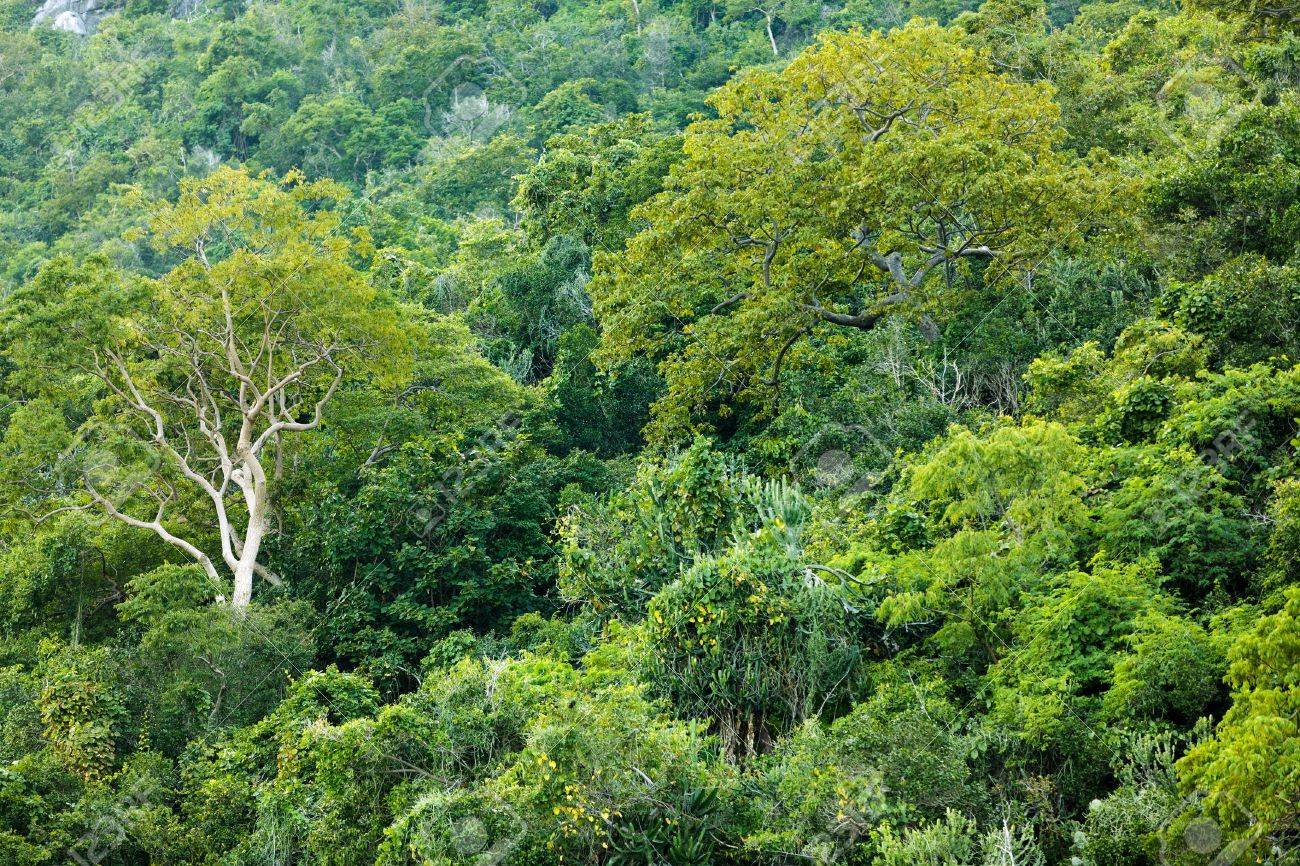
Sarpakaavu
What is Sarpakaavu and how to develop it?
(page last updated on 28th Aug 2022)
Page Index
- What is a Sarpakaavu?
- How to develop a Sarpakaavu?
- Stage 1: Land selection for developing a Sarpakaavu
- Stage 2: Construction of compound wall
- Stage 3:
- Land registration
- Documents to be submitted to M/s. Gurukripa Enterprises by the person who is developing Sarpakaavu within 90 days of date of implementation of pronouncement mentioned in death warrant batch (Set 1)
- Documents to be submitted to M/s. Gurukripa Enterprises by the person who is developing Sarpakaavu within 90 days of date of implementation of pronouncement mentioned in death warrant batch (Set 2)
- Stage 4: Land development
- Stage 5: Planting saplings
- Stage 6: Irrigation of saplings
- Stage 7: Responsibility as a care-taker of Sarpakaavu
- Documents to be submitted to M/s. Gurukripa Enterprises within 240 days of date of implementation of pronouncement mentioned in death warrant batch by the care-taker of Sarpakaavu (Set 3)
- Documents to be submitted to M/s. Gurukripa Enterprises after completing Sarpakaavu i.e., after 240 days of date of implementation of pronouncement mentioned in death warrant batch by the care-taker of Sarpakaavu (Set 4)
- Rules to be followed for developing Sarpakaavu
- Letter of agreement between M/s. Gurukripa Enterprises and the care-taker of Sarpakaavu
- Various layout plans for developing Sarpakaavu
- Layout plan of 225 cells (minimum 33.10 cents or 14400 sq. ft.)
- Layout plan of 169 cells (minimum 23 cents or 10176 sq. ft.)
- Layout plan of 121 cells (minimum 17.08 cents or 7744 sq. ft.)
- Layout plan of 64 cells (minimum 9.40 cents or 4096 sq. ft.)
- Layout plan of 54 cells (minimum 8 cents or 3456 sq. ft.)
- Layout plan of 32 cells (minimum 4.70 cents or 2048 sq. ft.)
- Layout plan of 30 cells (minimum 4.41 cents or 1920 sq. ft.)
- Layout plan of 9 cells (minimum 1.32 cents or 576 sq. ft.)
- Plan 1:- Plant 30 saplings
- Plan 2:- Plant 7 saplings
- Layout plans with cell measurement exceeding 64 sq. ft.
- Terms and conditions for creating Sarpakaavu
- Guidelines for creating Sarpakaavu
- Rules that are to be followed while creating Sarpakaavu
- Frequently Emerging Doubts
- Quick Links

What is a Sarpakaavu?
Sarpakaavu is a sacred abode of snakes. In other words, Sarpakaavu is a developed earmarked forest in a limited piece of land. This is an ancient practice of respecting and adoring Nature in return of various benefits we enjoy from the Holy Nature. Mother Nature is providing us sufficient food to survive, fresh and pollution-free pure air to breathe, purest of pure water to drink. This is the reason why we address Nature as our Holy Mother. In addition to this, Nature is providing us medicine to cure our illness and boost our immune system. Developing Sarpakaavu is therefore considered as an ultimate solution to get forgiveness for the offenses that we directly or indirectly commit towards the Holy Nature.
For Terms and conditions for developing Sarpakaavu (i.e., Option 2 a) click here
How to develop a Sarpakaavu?
Stage 1: Land selection for developing a Sarpakaavu
You need to locate ideal fertile land for this purpose. The value of the land should not be less than the total liable amount. The total liable amount should be fully utilized for purchasing the land alone. The land can be situated anywhere on Earth which is suitable for growing trees. It can be situated even in an interior remote place. The land need not be located at vantage point or at a commercially high value location. The land should have reasonable level of fertility, proximity to water sources and public road accessibility. (Even a narrow road is also fine). Preferably buy vacant land with no already grown-up trees. Land with already many grown-up trees is not ideal for developing Sarpakaavu. You should try to acquire more area of land with limited fund. This is possible if you buy the property in outskirts of the city/village. However, it is purely your choice.
Inside Sarpakaavu land, mark a perfect square or rectangle shape area (that is suitable for selected layout plan) having correct facing directions and ensuring the biggest possible area that can accommodate in Sarpakaavu land. The shape of Sarpakaavu land and its facing directions are also very critical while purchasing land for Sarpakaavu. Incorrect facing directions will result in wastage of land. A land which does not have a proper rectangular or square shape also cannot be utilized to the maximum. In order to make this point clear, some sketches are furnished below. Square or rectangular shaped land having proper facing directions without already grown-up trees is ideal for developing Sarpakaavu.
1. Land having square shape with correct facing directions:
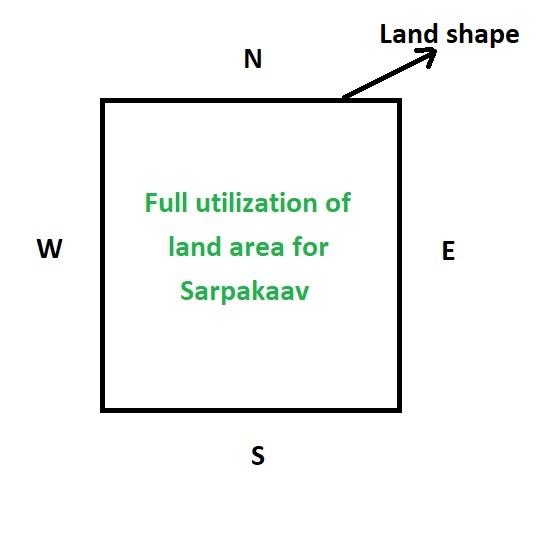
Result:
Maximum utilization with zero wastage.
2. Vertical or horizontal shaped rectangular land with correct facing directions:
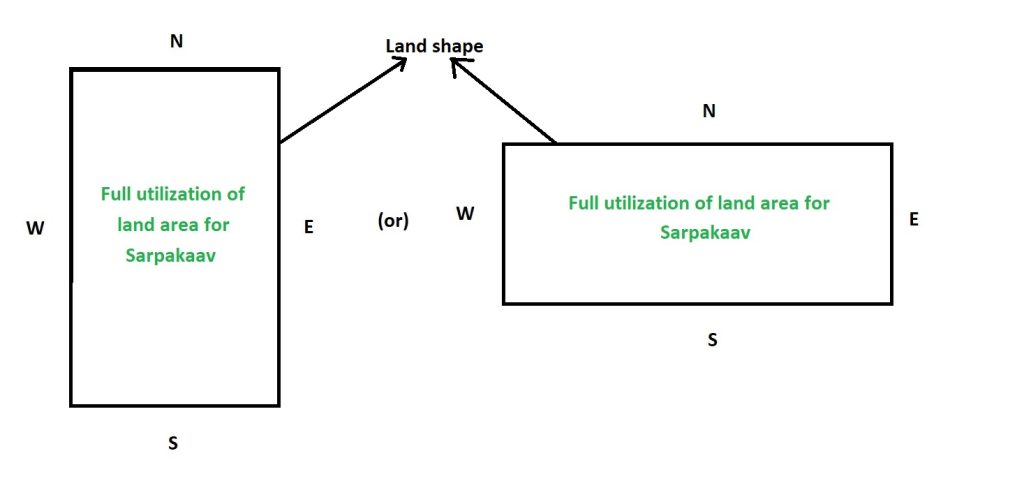
Result:
Maximum utilization with zero wastage.
3. Triangle shaped land:

Result:
Sarpakaavu can be developed only in a limited area inside the triangle as shown in the drawing.
4. An odd shaped land with incorrect facing directions:

Result:
Sarpakaavu can be developed only in a limited area as shown in the drawing.
5. A circle or oval shaped land:
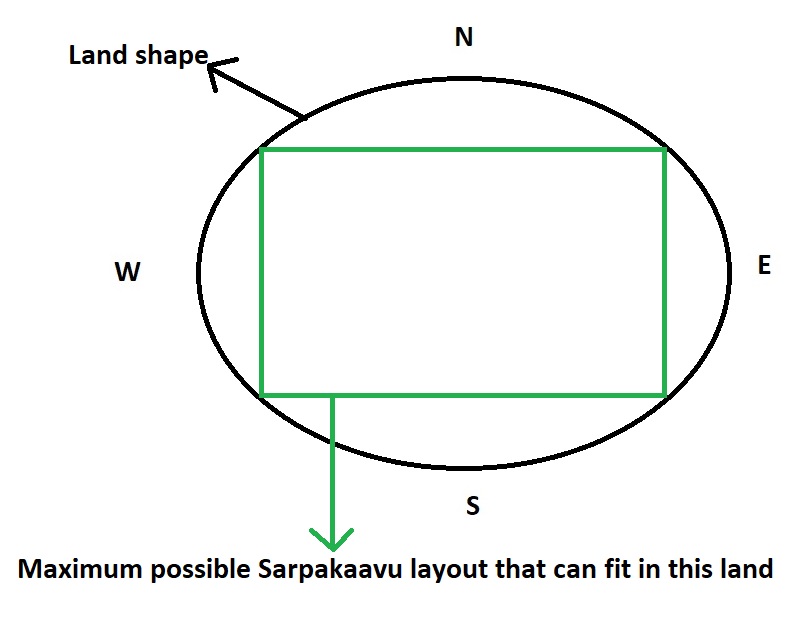
Result:
Sarpakaavu can be developed only in a limited area as shown in the drawing.
6. An odd shaped land:
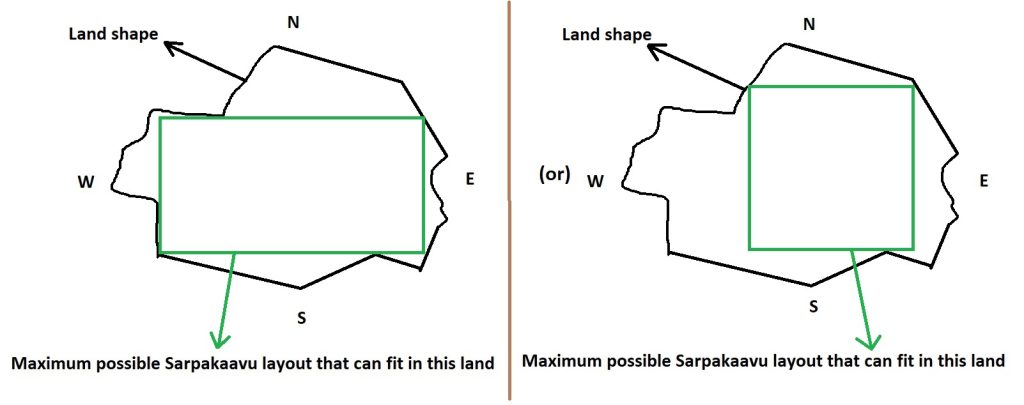
Result:
Sarpakaavu can be developed only in a limited area as shown in the drawing.
7. Land having perfect square shape but with incorrect facing directions:

Result:
Sarpakaavu can be developed only in a limited area as shown in the drawing.
Stage 2: Construction of compound wall
Two types of compound wall are required for developing a Sarpakaavu:
- Outer compound wall for Sarpakaavu land: Good quality, strong compound wall has to be constructed, surrounding all the boundaries of Sarpakaavu land. The land should have only one entrance which is accessible from public road. Provide a narrow gate at the entrance, which is not broader than 2 feet. Avoid entrance on the Northern side of the land. Outer compound wall should be of at least 10 inches thickness and 8 feet height from the land surface. It should be constructed providing a strong foundation. Compound wall can be constructed using rocks, concrete, hollow-less solid cement blocks/ strong clay bricks etc. No other permanent/temporary construction is allowed in the area inside the compound wall except a small motor-shed measuring not more than 100 sq. ft. This can be utilized for irrigation purpose or as a storage space for keeping land development equipment if required. However, motor shed is not mandatory for Sarpakaavu measuring less than 10 cents.
- Inner compound wall for the layout: Apart from the outer boundary wall with the specifications as mentioned above, another small compound wall need to be constructed around the layout boundary with a reasonably strong foundation and a small gate (not wider than 2 ft.) to enter into the layout area. Details of various layout plans and selection procedures are given below. The height of this layout boundary wall should be about 3.5 feet above the land surface and 4 inches thickness. Avoid entrance on the Northern side of the layout area. There is another option for constructing inner layout boundary wall which is with GI pipes and barbed wire fence with Arecanut trees. Below are the rules for this option which need to be strictly followed:
- GI pipes along with barbed wire fence should be installed exactly at the layout boundary line.GI pipes should be installed keeping a distance of 10 ft. along the layout boundary.
- Height of GI pipes should be 3.5 ft. above the land surface.
- Arecanut plants to be planted inside Sarpakaavu layout boundary barbed wire fence keeping a distance of 3 ft. from the barbed wire fence.
- The distance between the Arecanut plants should be 2 ft.
- Only “small seed, tall tree and non-hybrid” variety of Arecanut need to be used for this purpose. (Pharmacopia name: Areca catechu). Regular/common varieties of Arecanut having bigger seed or small height tree should not be used for this purpose.
- Note that this option of wall with Arecanut trees and barbed wire fence is only applicable to inner layout boundary wall and not outer compound wall of Sarpakaavu.
Note:
- Outer compound wall of Sarpakaavu land can be of any shape but the inner compound wall of the layout boundary should be either a square or a rectangle as per the selected layout plan.
- If Sarpakaavu land is in the shape of a square or rectangle and having correct facing directions in accordance with the layout plan then only one compound wall is sufficient having the specifications of an outer compound wall.
- Motor shed should be outside the inner layout boundary wall but inside the outer compound wall of Sarpakaavu.
- Electric board meter box should be outside the inner layout boundary. It can be mounted on the outer compound wall near the gate facing outwards. This makes the electric board authorities to conveniently note down the meter reading without having to enter into the Sarpakaavu land at appropriate time. Electric board meter box should contain an inner metal box attached to it with lock and key facility containing the electric connection fuse etc. This inner box should be kept always locked and under the supervision of the care-taker of Sarpakaavu. This will enable the safety of electric connection against any accidents and thefts.
- If any electric pole is required for providing electricity to Sarpakaavu land, then the pole should be strictly outside the Sarpakaavu land.
Stage 3:
Before planting the following activities should be completed:
- Compound wall construction
- Land registration in the name of M/s. Gurukripa Enterprises in the form of registered irrevocable power of attorney
a) Land registration
Before planting, the land identified for making a Sarpakaavu should to be registered in the name of M/s. Gurukripa Enterprises in our official company address. The land ownership should be completely in the name of M/s. Gurukripa Enterprises, as this is done as an act of remedial action for the mistake committed by you and to escape from the punishment. Registration of land in the name of M/s. Gurukripa Enterprises need to be done in the form of registered irrevocable power of attorney. Land registration process has to be completed within 90 days from the date of implementation of pronouncement mentioned in death warrant batch that is published in the official website of M/s. Gurukripa Enterprises. While considering purchase of land for the equivalent value of liable amount to develop Sarpakaavu, it is to be noted that the value shown in the document only will be considered as amount spent on land. This means under-valuation or over-valuation should not be done while registering the land. The responsibility of developing Sarpakaavu (specifically designed forest) in the registered land as per the guidelines of M/s. Gurukripa Enterprises is entirely yours, though irrevocable power of attorney of the land is registered in the name of M/s. Gurukripa Enterprises.
b) Documents to be submitted to M/s. Gurukripa Enterprises by the person who is developing Sarpakaavu within 90 days of date of implementation of pronouncement mentioned in death warrant batch (Set 1):
- Hard copy of your identity card approved by the government having the following information:
- Full name
- Full address
- Photograph
- Gender
- Date of birth
- Personal/general information
- Present occupation
- Past occupation(s)
- Recent photograph (not more than 6 months old)
- Place of stay (postal address – permanent as well as present)
- Official email id (if working) and personal email id (personal email id will be your registered email id with M/s. Gurukripa Enterprises. All communications will thereafter be sent to this personal email id)
- Primary contact number and alternate contact number
- Describe your offenses for which remedial measure is sought by quoting batch numbers of death warrant
- Distance between your place of stay and the identified location(s) of the proposed land for Sarpakaavu
- Brief description about your family
- Any other relevant information you wish to describe about yourself
- About the identified land for developing Sarpakaavu (physical hard papers only need to be submitted). Below details need to be furnished for each Sarpakaavu land separately in case of more than one Sarpakaavu:
- Full address of Sarpakaavu land
- Total measurement of Sarpakaavu land
- Which layout plan is being implemented?
- Sketch of the land approved by the registration authorities
- Encumbrance certificate of the land of the past 30 years
- Hard papers (not soft copy) of Irrevocable power of attorney (IPA) of Sarpakaavu land in the name of M/s. Gurukripa Enterprises (as per the local government format for registration) must be kept in a separate water-proof file inside the folder having your signatures/photograph etc. on it wherever required. Incomplete/inappropriate/irrelevant papers will not be accepted. These papers will be posted back to the sender for registration procedures. Full “from address” of the sender with contact number is mandatory on the parcel, which will be used for posting back these papers to the sender for registration. (Mark on the papers with pencil wherever signatures/seal of M/s. Gurukripa Enterprises are required for registration purpose.)
- The original title deed of the property (physical hard papers and not soft copy) has to be attached with irrevocable power of attorney duly registered.
- Previous title deed of the property (original hard papers, not copy)
- Latest land tax paid certificate
- Latest possession certificate
- No liability certificate
- In case the land earmarked for Sarpakaavu is only a portion of your property, you need to send self-attested hard copy of the original title deed along with registered irrevocable power of attorney (original hard papers), registered land sketch of parent property (self-attested hard copy) and registered land sketch of the sub divided property (self-attested original hard papers) that is earmarked for Sarpakaavu. The matter should be clearly mentioned in the irrevocable power of attorney i.e., “Original title deed of this land cannot be submitted to M/s. Gurukripa Enterprises as the above-said Sarpakaavu land is only a portion of my entire property having common title deed, whose original title deed and other related documents are with <name and details of the person having the documents>. Hence attaching its copy”
- Letter of agreement between M/s. Gurukripa Enterprises and care-taker of Sarpakaavu on a physical hard paper (not soft copy) in the given format (below) duly signed by the care-taker with date
- The above-mentioned documents/information should reach M/s. Gurukripa Enterprises within 90 days of the date of implementation of pronouncement mentioned in the corresponding death warrant batch to which you belong to.
- All the above-mentioned documents need to be submitted all together at a time. Part documents or incomplete set of documents will be rejected.
- From address of the sender should be provided in full along with the contact number while submitting the documents to M/s. Gurukripa Enterprises in case the documents get rejected and need to be sent back.
- Postal/courier charges of the parcel to be remitted in advance. Other cases will not be accepted.
- In case any document mentioned above, to be issued by the respective government is not available because of lack of proper government procedures, then a self-declaration about the same quoting the exact reason should be submitted with your dated signature on it, and need to be submitted to us as soon as it is made available by the government.
- Documents that are in national or local languages other than English need to be attached along with true translation of the matter in English with your signature and date.
- One line heading with sufficient details should be written in English on a paper and attached on top of each document for easy understanding of what the document is all about
- This list of Set 1 documents need to be enclosed with your dated signatures on all papers.
- You need to have a copy of all the documents before submitting in case of any need.
- All the above documents need to be packed (without folding) in a water-proof folder and submitted to M/s. Gurukripa Enterprises well in advance so that you get sufficient time for registration of IPA. Original documents need to be filed in separate water-proof files before inserting in the folder for additional safety.
c) Documents to be submitted to M/s. Gurukripa Enterprises by the person who is developing Sarpakaavu within 90 days of date of implementation of pronouncement mentioned in death warrant batch (Set 2):
- Registered irrevocable power of attorney (IPA) in the name of M/s. Gurukripa Enterprises.
- Fresh encumbrance certificate of Sarpakaavu land after registration of IPA.
Stage 4: Land development
Develop the land (if required) in such a way to plant saplings of selected long-life trees mentioned in the approved list of M/s. Gurukripa Enterprises. Land development does not mean completely levelling the ground. The land can also be moderately levelled step by step if it is a hilly terrain. You can take advices of local agriculturists or qualified people for preparing the ground appropriately. You should not disturb any long-life trees/plants that are already existing in the land while developing.
While developing the land, you have to keep in mind that the saplings to be planted in the land area need to be irrigated at least for few years initially. Accordingly you may arrange for irrigation facility so that all the saplings are irrigated well. At least thrice a week saplings need to be irrigated. In hot climatic conditions irrigating saplings twice a day is a must. Avoid watering the plants in afternoon when the atmosphere is too hot. Contaminated/impure water cannot be used for irrigating the saplings in case of external water sources. A well should be dug in the specified cell that is mentioned in the selected layout plan, specifications of which are given in the “Approved list of saplings for that layout plan” sheet. Using a non-submersible motor placed in the motor shed, water need to drawn from the well and used for irrigating saplings in Sarpakaavu land.
Stage 5: Planting saplings
Before planting, the following activities should be completed:
- Compound wall construction
- Land registration in the name of M/s. Gurukripa Enterprises in the form of registered irrevocable power of attorney (details given elsewhere in the report)
Now the land is ready for planting. Planting is to be done strictly as per the guidelines given by M/s. Gurukripa Enterprises only. Saplings need to be planted exactly as per the directions (i.e., East, West, North, South directions of the land).
Selection of Layout plan for planting:
- Various layout plans are given for your ready reference. You need to exactly follow the guidelines as given by M/s. Gurukripa Enterprises while planting the saplings i.e., planting has to be done exactly in the specified locations only.
- Select a layout plan (which is in square/rectangle shape) that fits the maximum land area inside the compound wall of Sarpakaavu having correct facing directions.
- Below given layout plan is an example of the land having square shape. Numbers represent cells where each set of saplings need to be planted.
- Cell numbers mentioned in all the layout plans are in accordance with the respective directions and this has to be strictly followed.
- A cell is of minimum measurement 8 ft. x 8 ft. = 64 sq. ft. to a maximum measurement of 16 ft. x 16 ft. = 256 sq. ft.
- All cells in the layout need to be of same measurements.
- For every layout plan, a list of approved saplings to be planted in specific cells is given. Planting needs to be done strictly according to this list only, which is approved by M/s. Gurukripa Enterprises.
- Plant saplings of only the approved list by M/s. Gurukripa Enterprises. Maintain a distance of 1 ft. between each sapling inside a cell. Select the exact variety of sapling according to the pharmacopeia name given in the list.
- No need of allocating separate area for footpath. Footpath can be of only 2 ft. width which can be adjusted with land area of adjacent cells. No specific construction is required for footpath. It is just a walk way for facilitating the care-taker to walk. If required tiles can be laid down in the footpath without the help of any other construction materials.
Refer various layout plans for details.
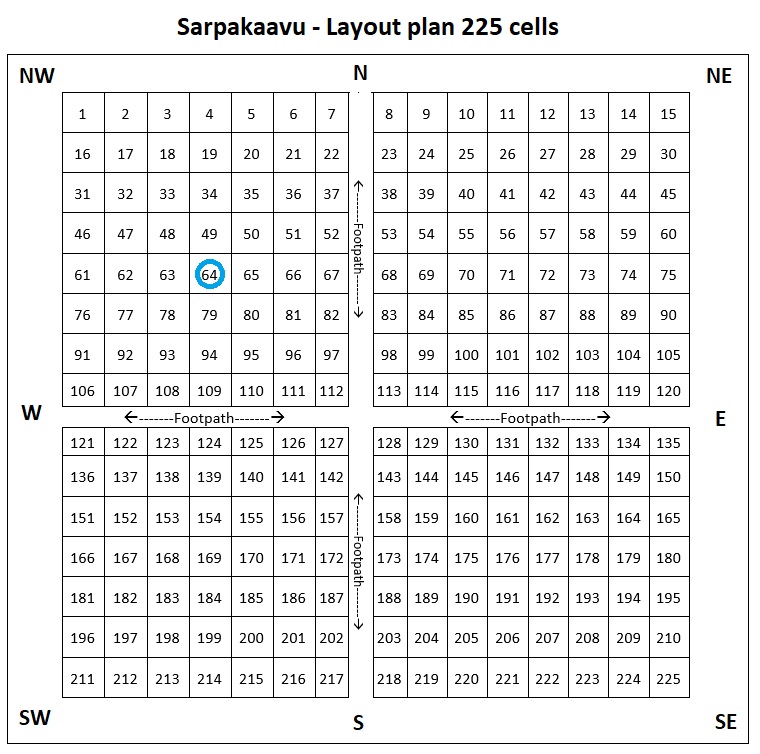
- Numbers represent cells where each set of saplings need to be planted
- E – East
- W – West
- S – South
- N – North
- NE – North East
- NW – North West
- SE – South East
- SW – South West
Land area in each cell as shown in the above layout is of minimum measurement 8 ft. x 8 ft. = 64 sq. ft. to a maximum measurement of 16 ft. x 16 ft. = 256 sq. ft.
The internal distance between the saplings within each cell should be approximately 1 ft. Start planting from the centre of the cell.
There is no need of constructing a separate compound wall for the layout boundaries, as the layout is already inside the compound wall of the registered land.
Plant only the approved varieties of tree saplings in each cell for developing Sarpakaavu.
For details of the approved list of saplings for each layout plan click here.
For details regarding procedure for planting, refer Planting procedure
Stage 6: Irrigation of saplings
Irrigate the saplings at least twice a week initially in summer season. You can use any type of irrigation facility including drip irrigation. The saplings should be protected from harsh sunlight by providing appropriate shadow. You need to re-plant fresh saplings of the same variety in case of insufficient growth/damage/unhealthy saplings etc. Your frequent personal care is required in the initial stages.
Stage 7:
a) Responsibility as a care-taker of Sarpakaavu
Within 2-3 years of planting saplings, the land will become a dense forest of young trees. You can spend your leisure time in that Sarpakaavu and these trees will be eager to give you their choicest fresh and pure air. The divine calmness will refresh your body and mind with immense power to face new challenges of your new life. Do not go deep inside Sarpakaavu as it is generally a prohibited area for human beings. No one including you should enter into Sarpakaavu during the nights at any cost. Sarpakaavu is a 100% restricted area for public. Sarpakaavu should be free from all types of encroachments and human interferences. No one shall be permitted to take anything from Sarpakaavu including fruits, flowers, leaves, branches, roots, mud etc. Honey extraction inside Sarpakaavu shall not be permitted. Researchers, tourists are also not permitted to enter into Sarpakaavu Provide a small pond (water body) if the land area is more than 50 cents. This pond will serve as a rain water harvesting centre during the rainy season and will provide water to the inhabitants of Sarpakaavu like birds, insects, snakes, squirrels etc. Your responsibility as a care taker of Sarpakaavu is life-long. However, you can hand-over this responsibility to another person subject to obtaining written approval from M/s. Gurukripa Enterprises when you are physically unable to discharge the responsibilities as a care-taker.
b) Documents to be submitted to M/s. Gurukripa Enterprises at the time of completing Sarpakaavu i.e., within 240 days from the date of implementation of pronouncement mentioned in death warrant batch (Set 3):
A specific identification code will be allotted to you once Set 2 documents are received. This identification code need to be kept confidential. All future correspondence should bear this code number for easy identification and reference.
Intimate (through email) of completion of Sarpakaavu as per the given guidelines, immediately after completing the work. Subject of the email should bear Sarpakaavu ID. Format of the email: Subject of the email should start with :- Sarpakaavu>”Sarpakaavu ID”.
c) Documents to be submitted to M/s. Gurukripa Enterprises after completing Sarpakaavu i.e., after 240 days from the date of implementation of pronouncement mentioned in death warrant batch (Set 4):
A specific identification code will be allotted to you once Set 2 documents are received. This identification code need to be kept confidential. All future correspondence should bear this code number for easy identification and reference.
- Monthly Status Report need to be emailed to M/s. Gurukripa Enterprises every month thereafter as per the given format. Click here for the format.
- Yearly receipt of land tax of Sarpakaavu land (soft copy to be emailed from the registered email id).

Rules to be followed for developing Sarpakaavu:
- Strictly avoid saplings developed using budding and grafting technologies with different varieties of tree combinations. Select saplings that are grown from the seeds of the approved trees as far as possible. Refer pharmacopeia names for authentic information.
- Plant only the approved varieties of tree saplings in each cell with exact directions as mentioned in each layout plan for developing Sarpakaavu. Follow the pharmacopeia name for the exact variety of sapling.
- Minimum area of land required for each cell is of measurement 8 ft. x 8 ft. = 64 sq. ft.
- Maximum area of land for each cell is of measurement 16 ft. x 16 ft. = 256 sq. ft.
- Each Sarpakaavu land must have separate compound wall with separate entrance gates even if they are adjacent.
- Layout boundary inside the Sarpakaavu land should have a smaller compound wall as specified.
- No permanent/temporary construction is allowed in the area inside the compound wall except a small motor-shed measuring not more than 100 sq. ft.
- Do not start planting saplings before completing the construction of compound wall with gate.
- A display board is to be erected on top of the gate facing the road with the following message written on the board

- Gate should be always kept closed under lock and key, ensuring no human/domestic animals’ interference inside the compound wall, especially after planting saplings. Nobody is allowed to enter into Sarpakaavu, other than the authorized registered care-taker with M/s. Gurukripa Enterprises. The land will be under the protection of Ateendriya Suraksha. Trespassers to this land hence will be severely punished by the forces of the Nature. However, the care-taker of Sarpakaavu should take good care of the property to avoid all possible untoward incidents.
- Planting of saplings to be completed before 150 days from the date of punishment. i.e., within 90+150=240 days
- Required quantity of organic manure to be used at the bottom of the pits before planting. This will ensure faster and healthier growth of the saplings. You may note that no chemical manure/ pesticides/ insecticides should be used in the land.
- All the saplings are to be planted by you personally, although you may take assistance of others for the remaining arrangements. While planting, you need to hold the saplings in your hands and pray to the Almighty Nature, facing East or North direction before planting. It is to be noted that the Almighty Nature does not have any affiliation towards any particular caste, creed, race, color, religion etc.
- If you are unable to get saplings of the trees that are mentioned in the approved list by M/s. Gurukripa Enterprises, then you can cultivate saplings using the seeds. This will ensure sufficient availability of required saplings within the time frame.
- If any of the saplings are getting damaged or unable to grow properly, then a new sapling of the same variety should be replanted in that place.
- Sarpakaavu is a 100% restricted area for public. It should be free from all types of encroachments and human interferences. No one shall be permitted to take anything from Sarpakaavu including fruits, flowers, seeds, leaves, branches, saplings, roots, mud etc. Honey extraction inside Sarpakaavu shall not be permitted. Researchers, tourists are also not permitted to enter Sarpakaavu.
- Sarpakaavu is the most sacred and holy place on Earth. Nobody can spit inside Sarpakaavu including you as a care-taker as well as the workers working there during the initial stages of land development.
- Footwear is not allowed inside Sarpakaavu
- Anybody who is having a cut/injury anywhere in their body externally, either small or big are not supposed to enter into Sarpakaavu until it is completely cured. This is applicable to care-takers, workers etc of all genders. If the registered and approved care-taker of Sarpakaavu is a female, then she is not supposed to enter into Sarpakaavu (inside the compound wall) during the menstrual period. This should be strictly observed. This is also applicable to the female workers who are allowed to enter inside Sarpakaavu during the initial land development stage.
- Persons who have taken non-vegetarian food are not allowed inside unless they take bath. This is applicable to even the workers coming there.
- Persons who have attended cremation ceremony or have visited a grave yard cannot enter Sarpakaavu land on that day. Next day they need to take head and body bath before entering into Sarpakaavu land.
- Sarpakaavu is an area that has to be maintained with utmost sanctity, hygiene, cleanliness etc. Anybody who is throwing any filth or wastage in Sarpakaavu land knowingly or unknowingly, intentionally or unintentionally, their 7 generations will be very severely punished. Ignorance is not an excuse.
- In case any of the above rules are not followed, then immediately the land will loose the status of Sarpakaavu and become a mere forest. The land will loose charge and hence it cannot give you sufficient energy required for the purpose of developing Sarpakaavu. It cannot give you the benefits of the required remedial measure. However you will keep getting the benefits of a forest.
- In case of any untoward incident violating any of the above rules, the care-taker need to immediately inform M/s. Gurukripa Enterprises (via email mentioning Sarpakaavu ID and in the specified format) describing the violated activity, requesting for recharge. If the Acharai feels that it is genuine, then recharging will be done. No physical presence of Acharai is required for this recharging activity irrespective of the geographical location of Sarpakaavu land. This recharging can be done utmost thrice in life-time. If it exceeds that count, the request will no more be considered for further recharging.
- If any filth or wastage is thrown in Sarpakaavu land by any person with intention of enmity towards the care-taker, then that recharging count of Sarpakaavu land because of this reason need not be counted in the maximum no. of times allowed for recharging that Sarpakaavu land. Such persons who have thrown filth will be punished adequately by the invisible forces of the Nature.
- The care-taker of Sarpakaavu is the only permitted person to enter into that Sarpakaavu. He/she can make use of the footpath for exercise or walking during the day time only. Others are strictly prohibited from entering into Sarpakaavu even though they are closely associated or connected to the care-taker.
- Apart from the purpose of irrigating the saplings, water from the well of Sarpakaavu can be taken only by the care-taker of that Sarpakaavu and no body else, nor even the near and dear ones of the care-taker. This is to be strictly ensured.
- List of documents as specified in Set 1, Set 2, Set 3 and Set 4 need to be submitted to M/s. Gurukripa Enterprises within the specified timeframes.

Letter of agreement between M/s. Gurukripa Enterprises and care-taker of Sarpakaavu:
Sarpakaavu land details:
- Full address of Sarpakaavu land:
- Total area of Sarpakaavu :
Details of the care-taker of Sarpakaavu:
- Title and name of the care-taker of Sarpakaavu:
- Full address of the care-taker:
- Contact number:
- Alternate contact number (if any):
- Email id (all further communication will be via this email id):
- Government authorized photo ID proof number enclosed herewith:
a) Roles and responsibilities of the care-taker of the newly identified and registered land for developing Sarpakaavu:
- Land acquisition to be done within 90 days from the date of implementation of pronouncement mentioned in death warrant batch
- Land registration in the name of M/s. Gurukripa Enterprises to be done within 90 days from the date of implementation of pronouncement mentioned in death warrant batch
- Compound wall construction as per the guidelines
- Land development to make it suitable for planting saplings
- Make a pond/well for rain water harvesting at the directed location
- Making arrangements for irrigation
- Arrange sufficient saplings for planting
- Plant selected saplings at the specified locations in the land area as given
- Watering the plants at regular intervals at least twice a week
- Making arrangements for replanting of damaged saplings (Replanting to be done by the developer of Sarpakaavu)
- To ensure that rules for developing Sarpakaavu are followed as given in the website
- To ensure that no one is allowed inside the land other than the workers for initial land development stage
- To ensure that no one is permitted to take anything from the developed Sarpakaavu. To list a few – fruits, flowers, any part of the tree including dry leaves and dry wood, roots, mud etc
- No honey extraction is permitted inside the compound wall
- No one is allowed to cut grass inside Sarpakaavu nor allow any domestic animals to graze inside. No one should be allowed to enter into Sarpakaavu for the sake of site-seeing, bird-watching, research, collecting saplings/seeds etc or any other activities
- No one should be allowed to take photographs/video/shooting etc inside Sarpakaavu
- Care taker of Sarpakaavu should inform us immediately if government is planning to lay down any electrical or telephone line over Sarpakaavu land area or cut down any portion of Sarpakaavu for road extension etc
- Care taker of Sarpakaavu should inform us immediately if there is any damage to the compound wall or any other portion of Sarpakaavu
- To ensure that no posters or any kind of labels, stickers, advertisements are stuck on the compound wall of Sarpakaavu
- Electronic devices, electrical equipment (other than motor for irrigating Sarpakaavu), radio, mobile phones, devices, written matters, newspapers, any kind of books, cameras etc are strictly not permitted inside Sarpakaavu, except a chair for the care-taker (if required). However, life-saving/life-supporting electronic devices that are required by the care-taker are permitted. Eg: pacemaker of heart. The care-taker can utilize the footpath of Sarpakaavu for walking.
- No CCTV, no cabling is allowed inside Sarpakaavu.
- Care-taker of Sarpakaavu need to remove only the invading weeds/creepers that grow in Sarpakaavu land after planting saplings. Any other plant or climber that comes up naturally later are not to be removed.
- Forward a monthly status report to M/s. Gurukripa Enterprises head office as per the given format
b) Procedures for appointing a new care-taker of Sarpakaavu:
- Forward your recommendation to M/s. Gurukripa Enterprises about the identified individual
- Specify your views about the individual, about his/her integrity, capability, reliability, commitment and concern/obligation towards the Nature. Specify the status of physical and mental fitness etc of the individual
- Handover the charge and keys only after getting written approval from the authorized official of M/s. Gurukripa Enterprises
- You shall visit Sarpakaavu whenever possible even after your retirement as a care-taker and forward your observations to us
c) Self declaration:
I, <name of the care-taker>, bearing <ID proof number> and residing at the above-mentioned address have gone through all the above terms and conditions related to the above mentioned Sarpakaavu land and whole-heartedly express my willingness to adhere and undertake all the responsibilities and agree to follow all the guidelines given by M/s. Gurukripa Enterprises at present and in future in this regard. I shall implement all directions issued by M/s. Gurukripa Enterprises for developing Sarpakaavu in the land purchased/owned by me (as mentioned above) and handed over to M/s. Gurukripa Enterprises and shall bear all the connected expenses.
I shall execute all the above plans of action i.e., acquiring the land, land registration, land development, construction of the compound walls, digging well, payment of corresponding bills in time, planting saplings as per the layout plan, irrigating and taking good care of the saplings for developing a dense Sarpakaavu etc as per the given guidelines at my own expenses.
Signature:
Date:
Place:
This letter of agreement should reach M/s. Gurukripa Enterprises on or before the 90th day from the date of implementation of pronouncement mentioned in death warrant batch.

Various layout plans for developing Sarpakaavu:
1) Layout plan of 225 cells (minimum 33.10 cents or 14400 sq. ft.)
- Total no. of cells = 225 cells.
- Each cell is of minimum measurement 8 ft. x 8 ft. = 64 sq. ft. to a maximum measurement of 16 ft. x 16 ft. = 256 sq. ft.
- No need of allocating separate area for footpath. Footpath can be of only 2 ft. width which can be adjusted with land area of adjacent cells.
- Minimum land area for this layout (i.e., with 8 ft. x 8 ft. cell measurements) = (15 x 15) no. of cells x (8 ft. x 8 ft.) cell measurement = 33.10 cents or 14400 sq. ft.
- Maximum land area for this layout (i.e., with 16 ft. x 16 ft. cell measurements) = (15 x 15) no. of cells x (16 ft. x 16 ft.) cell measurement = 132.24 cents or 57600 sq. ft.
- Internal footpaths are not mandatory. However space for irrigation should be facilitated.

Click here for approved saplings list for developing Sarpakaavu with 225 cells layout plan (minimum area 33.10 cents or 14400 sq. ft.)
Terms and conditions for creating Sarpakaavu
Guidelines for creating Sarpakaavu
Rules that are to be followed while creating Sarpakaavu
2) Layout plan of 169 cells (minimum 23 cents or 10176 sq. ft.)
- Total no. of cells = 169 cells.
- Each cell is of minimum measurement 8 ft. x 8 ft. = 64 sq. ft. to a maximum measurement of 16 ft. x 16 ft. = 256 sq. ft.
- No need of allocating separate area for footpath. Footpath can be of only 2 ft. width which can be adjusted with land area of adjacent cells.
- Minimum land area for this layout (i.e., with 8 ft. x 8 ft. cell measurements) = (13 x 13) no. of cells x (8 ft. x 8 ft.) cell measurement = 23 cents or 10176 sq. ft.
- Maximum land area for this layout (i.e., with 16 ft. x 16 ft. cell measurements) = (13 x 13) no. of cells x (16 ft. x 16 ft.) cell measurement = 99.32 cents or 43264 sq. ft.
- Internal footpaths are not mandatory. However space for irrigation should be facilitated.
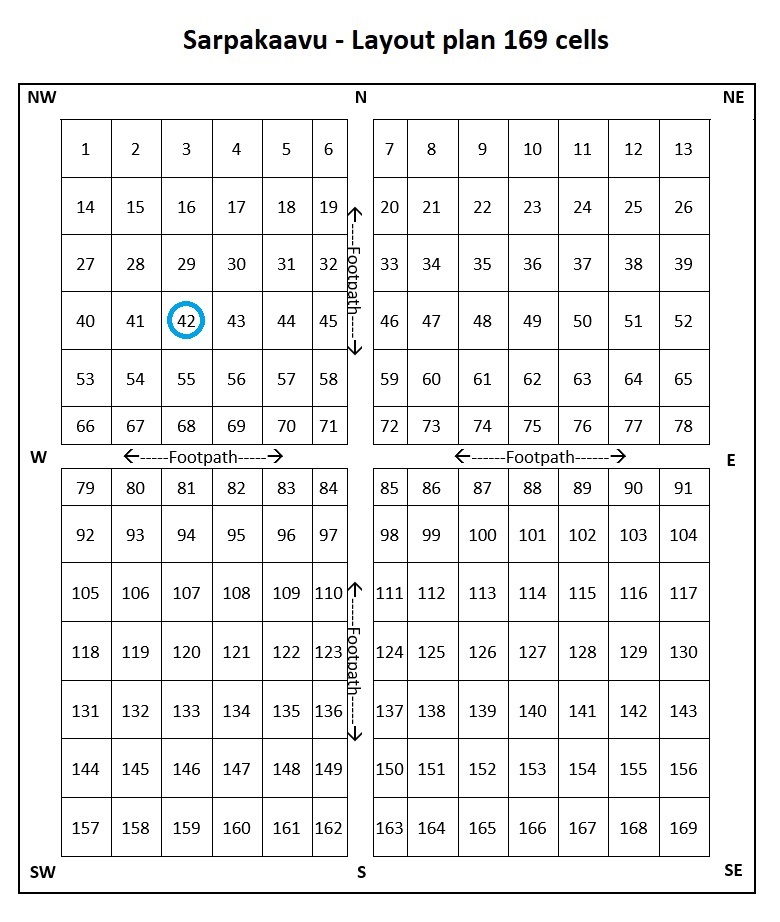
Click here for approved saplings list for developing Sarpakaavu with 169 cells layout plan (minimum area 23 cents or 10176 sq. ft.)
Terms and conditions for creating Sarpakaavu
Guidelines for creating Sarpakaavu
Rules that are to be followed while creating Sarpakaavu
3) Layout plan of 121 cells (minimum 17.08 cents or 7744 sq. ft.)
- Total no. of cells = 121 cells.
- Each cell is of minimum measurement 8 ft. x 8 ft. = 64 sq. ft. to a maximum measurement of 16 ft. x 16 ft. = 256 sq. ft.
- No need of allocating separate area for footpath. Footpath can be of only 2 ft. width which can be adjusted with land area of adjacent cells.
- Minimum land area for this layout (i.e., with 8 ft. x 8 ft. cell measurements) = (11 x 11) no. of cells x (8 ft. x 8 ft.) cell measurement = 17.08 cents or 7744 sq. ft.
- Maximum land area for this layout (i.e., with 16 ft. x 16 ft. cell measurements) = (11 x 11) no. of cells x (16 ft. x 16 ft.) cell measurement) = 71.11 cents or 30976 sq. ft.
- Internal footpaths are not mandatory. However space for irrigation should be facilitated.
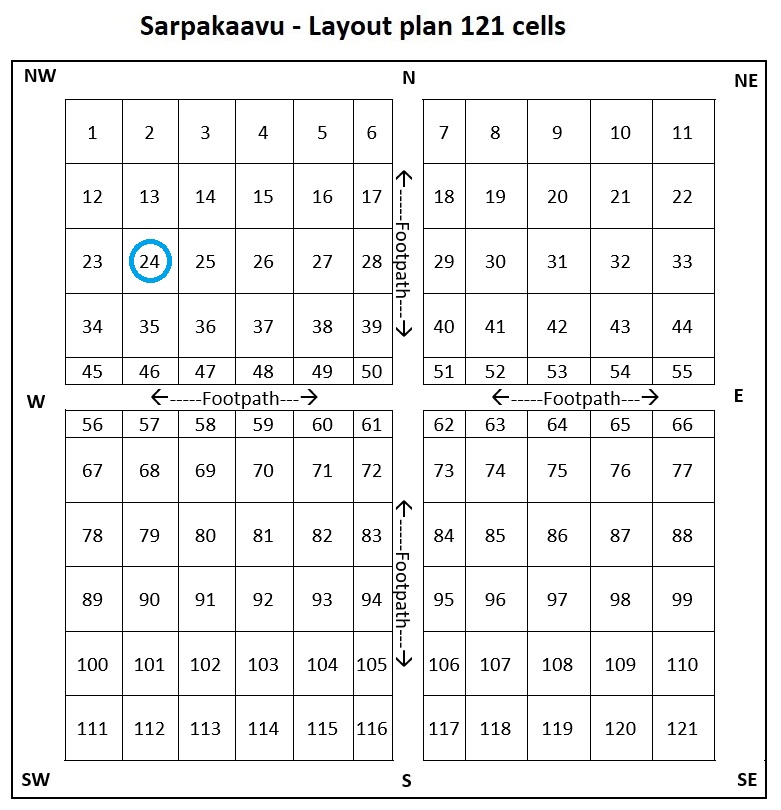
Click here for approved saplings list for developing Sarpakaavu with 121 cells layout plan (minimum area 17.08 cents or 7744 sq. ft.)
Terms and conditions for creating Sarpakaavu
Guidelines for creating Sarpakaavu
Rules that are to be followed while creating Sarpakaavu
4) Layout plan of 64 cells (minimum 9.40 cents or 4096 sq. ft.)
- Total no. of cells = 64 cells.
- Each cell is of minimum measurement 8 ft. x 8 ft. = 64 sq. ft. to a maximum measurement of 16 ft. x 16 ft. = 256 sq. ft.
- No need of allocating separate area for footpath. Footpath can be of only 2 ft. width which can be adjusted with land area of adjacent cells.
- Minimum land area for this layout (i.e., with 8 ft. x 8 ft. cell measurements) = (8 x 8) no. of cells x (8 ft. x 8 ft.) cell measurement = 9.40 cents or 4096 sq. ft.
- Maximum land area for this layout (i.e., with 16 ft. x 16 ft. cell measurements) = (8 x 8) no. of cells x (16 ft. x 16 ft.) cell measurement = 37.61 cents or 16384 sq. ft.
- Internal footpaths are not mandatory. However space for irrigation should be facilitated.
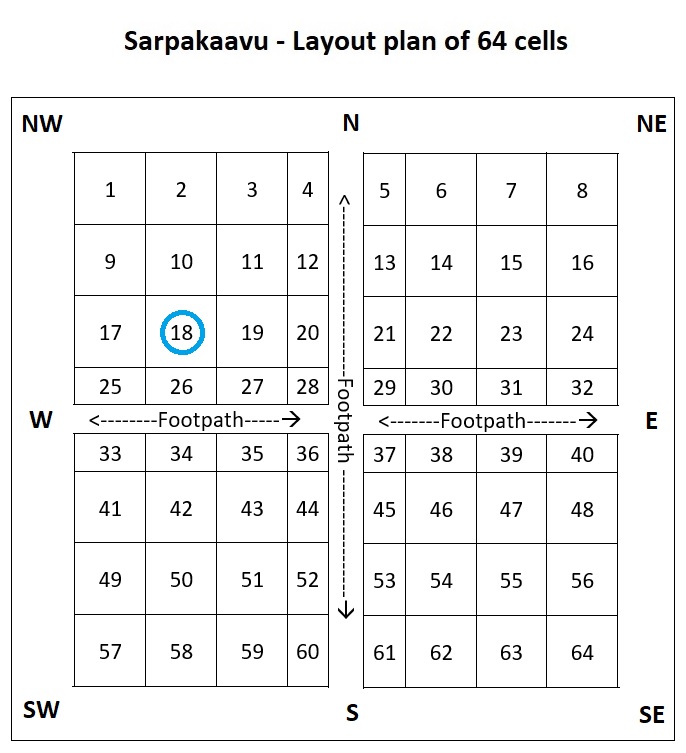
Click here for approved saplings list for developing Sarpakaavu with 64 cells layout plan (minimum area 9.40 cents or 4096 sq. ft.)
Terms and conditions for creating Sarpakaavu
Guidelines for creating Sarpakaavu
Rules that are to be followed while creating Sarpakaavu
5) Layout plan of 54 cells (minimum 8 cents or 3456 sq. ft.)
- Total no. of cells = 54 cells.
- Each cell is of minimum measurement 8 ft. x 8 ft. = 64 sq. ft. to a maximum measurement of 16 ft. x 16 ft. = 256 sq. ft.
- No need of allocating separate area for footpath. Footpath can be of only 2 ft. width which can be adjusted with land area of adjacent cells.
- Minimum land area for this layout (i.e., with 8 ft. x 8 ft. cell measurements) = (6 x 9) no. of cells x (8 ft. x 8 ft.) cell measurement = 8 cents or 3456 sq. ft.
- Maximum land area for this layout (i.e., with 16 ft. x 16 ft. cell measurements) = (6 x 9) no. of cells x (16 ft. x 16 ft.) cell measurement = 32 cents or 13824 sq. ft.
- Internal footpaths are not mandatory. However space for irrigation should be facilitated.
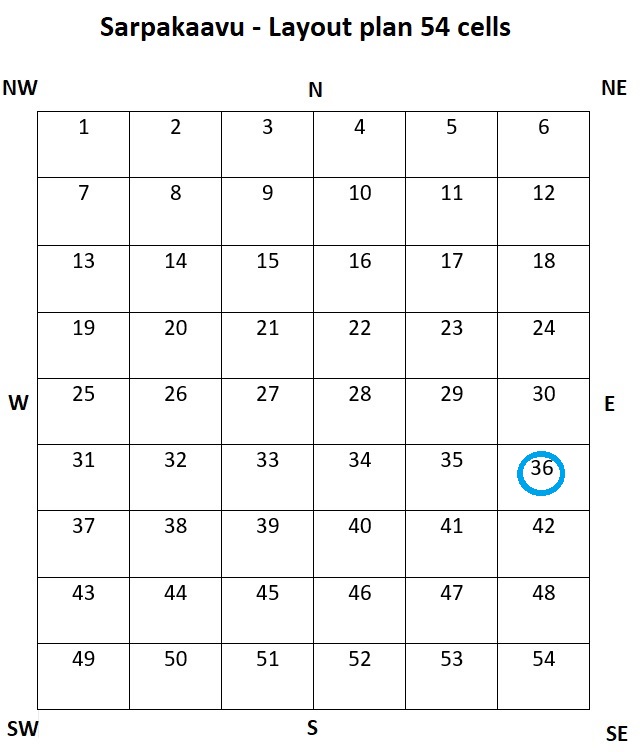
Click here for approved saplings list for developing Sarpakaavu with 54 cells layout plan (minimum area 8 cents or 3456 sq. ft.)
Terms and conditions for creating Sarpakaavu
Guidelines for creating Sarpakaavu
Rules that are to be followed while creating Sarpakaavu
6) Layout plan of 32 cells (minimum 4.70 cents or 2048 sq. ft.)
- Total no. of cells = 32 cells.
- Each cell is of minimum measurement 8 ft. x 8 ft. = 64 sq. ft. to a maximum measurement of 16 ft. x 16 ft. = 256 sq. ft.
- No need of allocating separate area for footpath. Footpath can be of only 2 ft. width which can be adjusted with land area of adjacent cells.
- Minimum land area for this layout (i.e., with 8 ft. x 8 ft. cell measurements) = (8 x 4) no. of cells x (8 ft. x 8 ft.) cell measurement =4.70 cents or 2048 sq. ft.
- Maximum land area for this layout (i.e., with 16 ft. x 16 ft. cell measurements) = (8 x 4) no. of cells x (16 ft. x 16 ft.) cell measurement = 18.8 cents or 8192 sq. ft.
- Internal footpaths are not mandatory. However space for irrigation should be facilitated.
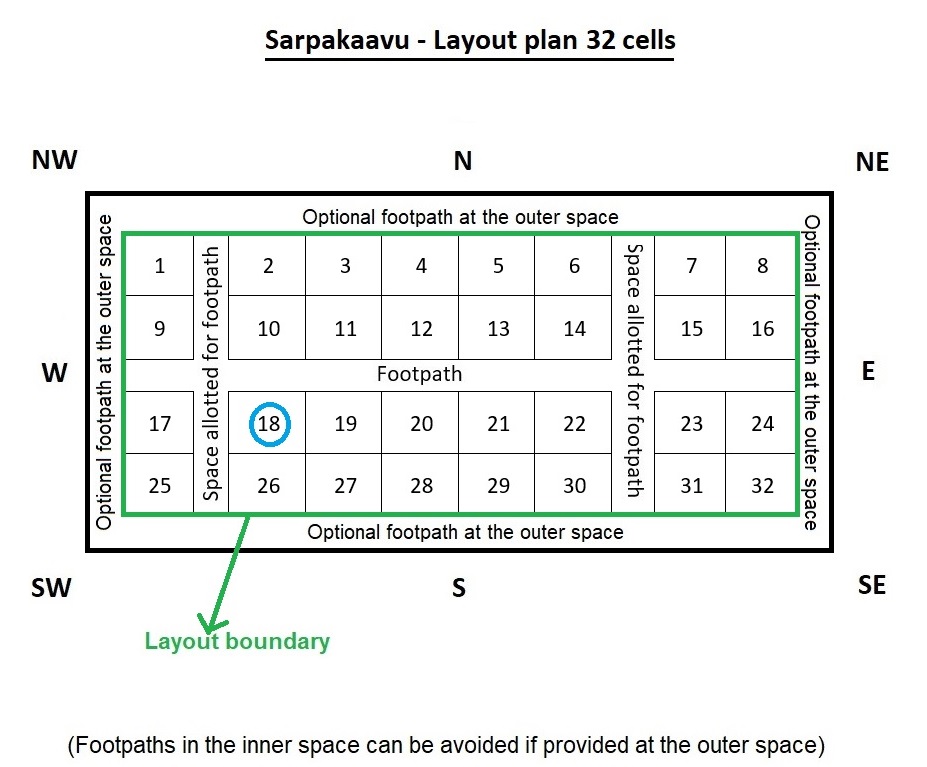
Click here for approved saplings list for developing Sarpakaavu with 32 cells layout plan (minimum area 4.70 cents or 2048 sq. ft.)
Terms and conditions for creating Sarpakaavu
Guidelines for creating Sarpakaavu
Rules that are to be followed while creating Sarpakaavu
7) Layout plan of 30 cells (minimum 4.41 cents or 1920 sq. ft.)
- Total no. of cells = 30 cells.
- Each cell is of minimum measurement 8 ft. x 8 ft. = 64 sq. ft. to a maximum measurement of 16 ft. x 16 ft. = 256 sq. ft.
- No need of allocating separate area for footpath. Footpath can be of only 2 ft. width which can be adjusted with land area of adjacent cells.
- Minimum land area for this layout (i.e., with 8 ft. x 8 ft. cell measurements) = (5 x 6) no. of cells x (8 ft. x 8 ft.) cell measurement = 4.41 cents or 1920 sq. ft.
- Maximum land area for this layout (i.e., with 16 ft. x 16 ft. cell measurements) = (5 x 6) no. of cells x (16 ft. x 16 ft.) cell measurement = 17.6 cents or 7680 sq. ft.
- Internal footpaths are not mandatory. However space for irrigation should be facilitated.
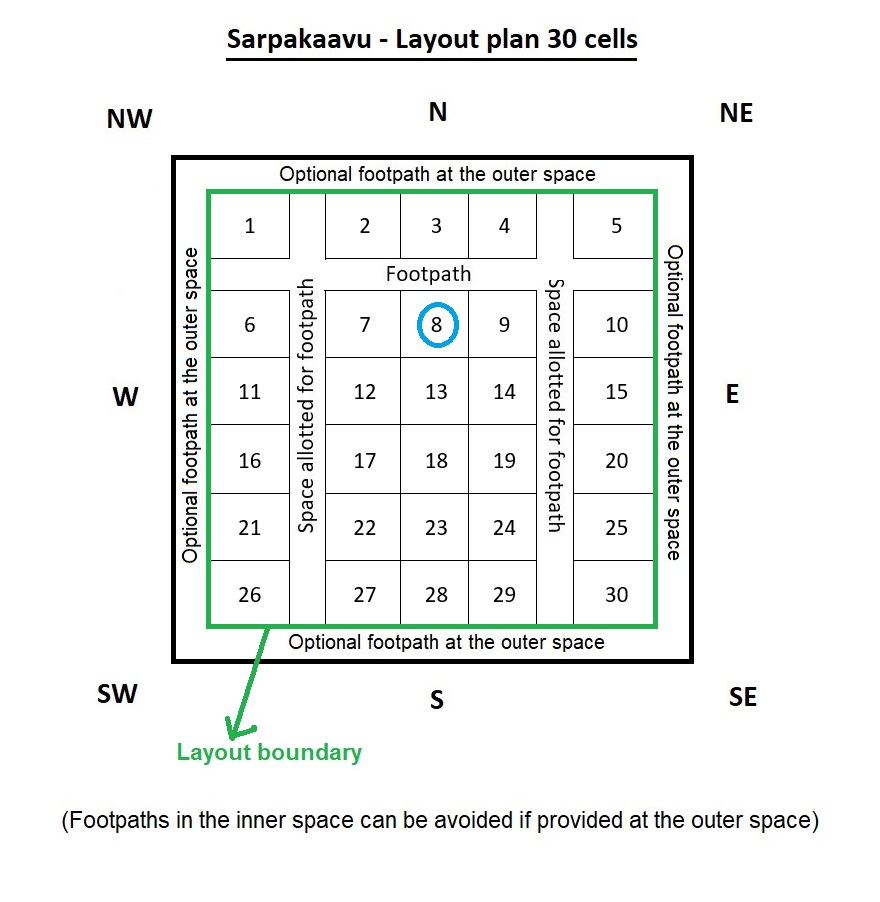
Click here for approved saplings list for developing Sarpakaavu with 30 cells layout plan (minimum area 4.41 cents or 1920 sq. ft.)
Terms and conditions for creating Sarpakaavu
Guidelines for creating Sarpakaavu
Rules that are to be followed while creating Sarpakaavu
8) Layout plan of 9 cells (minimum 1.32 cents or 576 sq. ft.)
- Total no. of cells = 9 cells.
- Each cell is of minimum measurement 8 ft. x 8 ft. = 64 sq. ft. to a maximum measurement of 16 ft. x 16 ft. = 256 sq. ft.
- No need of allocating separate area for footpath. Footpath can be of only 2 ft. width which can be adjusted with land area of adjacent cells.
- Minimum land area for this layout (i.e., with 8 ft. x 8 ft. cell measurements) = (3 x 3) no. of cells x (8 ft. x 8 ft.) cell measurement = 1.32 cents or 576 sq. ft.
- Maximum land area for this layout (i.e., with 16 ft. x 16 ft. cell measurements) = (3 x 3) no. of cells x (16 ft. x 16 ft.) cell measurement = 5.28 cents or 2304 sq. ft.
- This is the smallest Sarpakaavu one can make.
- Internal footpaths are not mandatory. However space for irrigation should be facilitated.
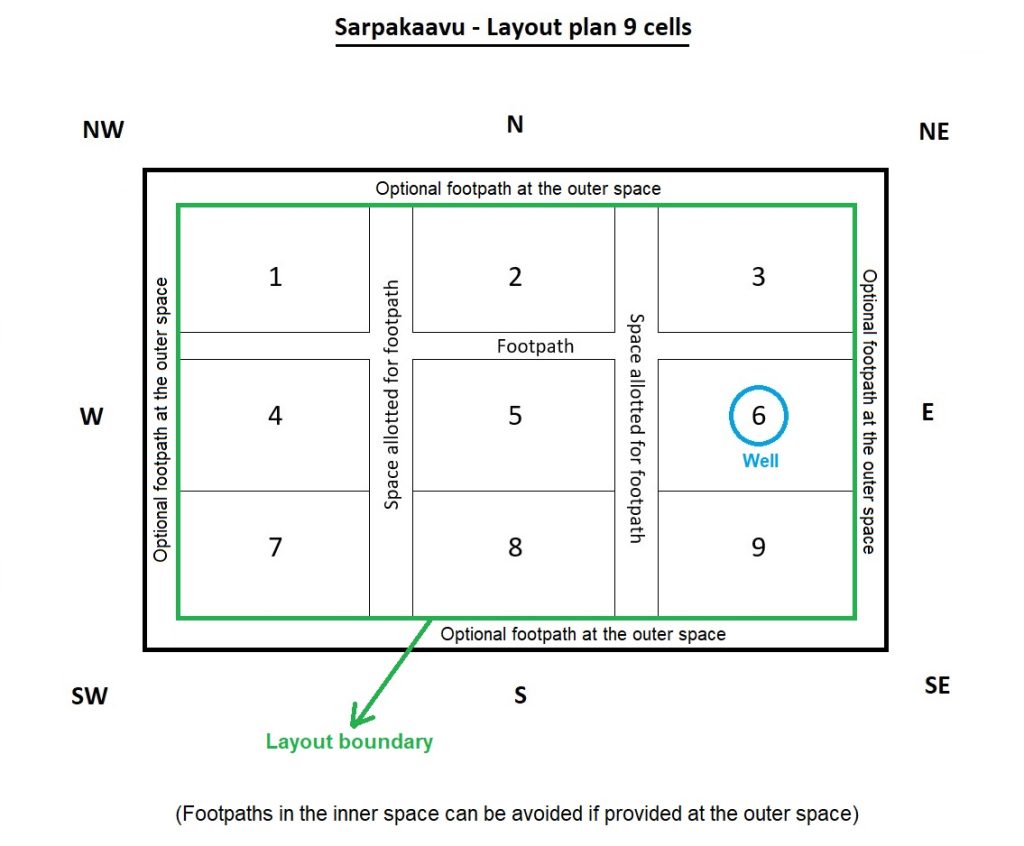
Click here for approved saplings list for developing Sarpakaavu with 9 cells layout plan (minimum area 1.32 cents or 576 sq. ft.)
Terms and conditions for creating Sarpakaavu
Guidelines for creating Sarpakaavu
Rules that are to be followed while creating Sarpakaavu
9) Plan 1:- Plant 30 saplings
- This plan is applicable for a maximum limit of USD 3000 liable amount.
- Keeping the purpose in mind plant 30 saplings. Planting can be done in any appropriate place, including road-sides (with the permission of local authorities). Registration of land in this case is not required unlike in other layout plans for developing Sarpakaavu. You have to ensure that these saplings are adequately protected and taken care until they become self-sufficient. Survival of these trees make you free from punishments. If these trees get damaged due to any natural calamity, re-planting has to be done immediately 10 times more than the original number of trees. You should ensure that a minimum of 30 long-life trees should be available at any point of time. Hence it is better to plant more number of saplings to avoid any unforeseen risks. This must be completed within the due date.
- It is to be noted that planting of saplings should be done personally with your own hands, although you may take assistance of others for the rest of the work. You will not be eligible for any benefit if the planting is done by any other individual other than you.
10) Plan 2:- Plant 7 saplings
- This plan is applicable for a maximum limit of USD 1000 liable amount.
- Keeping the purpose in mind plant 7 saplings. Planting can be done in any appropriate place, including road-sides (with the permission of local authorities). Registration of land in this case is not required unlike in other layout plan for developing Sarpakaavu. You have to ensure that these saplings are adequately protected and taken care until they become self-sufficient. Survival of these trees make you free from punishments. If these trees get damaged due to any natural calamity, re-planting has to be done immediately 10 times more than the original number of trees. You should ensure that a minimum of 7 long-life trees should be available at any point of time. Hence it is better to plant more number of saplings to avoid any unforeseen risks. This must be completed within the due date.
- It is to be noted that planting of saplings should be done personally with your own hands, although you may take assistance of others for the rest of the work. You will not be eligible for any benefit if the planting is done by any other individual other than you.
Layout plans with cell measurement exceeding 64 sq. ft.
- Increase the land area of the cell proportionately to accommodate the land availability. Do not increase the area in just one direction. It should be increased evenly all over. All cells should have the same measurements. The position of the cells should not be disturbed at any cost.
- Increase the cell size from 8 ft. x 8 ft. = 64 sq. ft. to a maximum of 256 sq. ft. i.e., 16 ft. x 16 ft. = 256 sq. ft. Below given tables would help you to understand better while making the expansion. You should not make any compromise on the total no. of cells i.e., 225 while increasing the cell size.
- 225 is the maximum number of cells a Sarpakaavu can have.
- Minimum land area of a cell is 8 ft. x 8 ft. = 64 sq. ft.
- Maximum land area of a cell should not exceed 256 sq. ft. (i.e., 16 ft. x 16 ft. = 256 sq. ft.)
- All cells of a Sarpakaavu should constitute same measurements.
|
Sl. No. |
Cell measurements |
Total area of the cell (sq. ft.) |
Total no. of cells |
Total measurement of Sarpakaavu |
|
1 |
8 ft. x 8 ft. (Minimum) |
64 sq. ft. |
225 |
14400 sq. ft. (33.10 cents) |
|
2 |
9 ft. x 9 ft. |
81 sq. ft. |
225 |
18225 sq. ft. (41 cents) |
|
3 |
10 ft. x 10 ft. |
100 sq. ft. |
225 |
22500 sq. ft. (51 cents) |
|
4 |
11 ft. x 11 ft. |
121 sq. ft. |
225 |
27225 sq. ft. (62 cents) |
|
5 |
12 ft. x 12 ft. |
144 sq. ft. |
225 |
32400 sq. ft. (74 cents) |
|
6 |
13 ft. x 13 ft. |
169 sq. ft. |
225 |
38025 sq. ft. (87 cents) |
|
7 |
14 ft. x 14 ft. |
196 sq. ft. |
225 |
44100 sq. ft. (101 cents) |
|
8 |
15 ft. x 15 ft. |
225 sq. ft. |
225 |
50625 sq. ft. (116 cents) |
|
9 |
16 ft. x 16 ft. (Maximum) |
256 sq. ft. |
225 |
57600 sq. ft. (133 cents) |
The cell can also have any of the below measurements. All cells in Sarpakaavu should have the same selected measurements. This is applicable for all layout plans.
|
8 ft.x 8 ft. (Minimum cell area) |
9 ft.x 8 ft. |
10 ft.x 8 ft. |
11 ft.x 8 ft. |
12 ft.x 8 ft. |
13 ft.x 8 ft. |
14 ft.x 8 ft. |
15 ft.x 8 ft. |
16 ft.x 8 ft. |
|
8 ft. x 9 ft. |
9 ft.x 9 ft. |
10 ft.x 9 ft. |
11 ft.x 9 ft. |
12 ft.x 9 ft. |
13 ft.x 9 ft. |
14 ft.x 9 ft. |
15 ft.x 9 ft. |
16 ft.x 9 ft. |
|
8 ft. x 10 ft. |
9 ft.x 10 ft. |
10 ft.x 10 ft. |
11 ft.x 10 ft. |
12 ft.x 10 ft. |
13 ft.x 10 ft. |
14 ft.x 10 ft. |
15 ft.x 10 ft. |
16 ft.x 10 ft. |
|
8 ft.x 11 ft. |
9 ft.x 11 ft. |
10 ft.x 11 ft. |
11 ft.x 11 ft. |
12 ft.x 11 ft. |
13 ft.x 11 ft. |
14 ft.x 11 ft. |
15 ft.x 11 ft. |
16 ft.x 11 ft. |
|
8 ft.x 12 ft. |
9 ft.x 12 ft. |
10 ft.x 12 ft. |
11 ft.x 12 ft. |
12 ft.x 12 ft. |
13 ft.x 12 ft. |
14 ft.x 12 ft. |
15 ft.x 12 ft. |
16 ft.x 12 ft. |
|
8 ft.x 13 ft. |
9 ft.x 13 ft. |
10 ft.x 13 ft. |
11 ft.x 13 ft. |
12 ft.x 13 ft. |
13 ft.x 13 ft. |
14 ft.x 13 ft. |
15 ft.x 13 ft. |
16 ft.x 13 ft. |
|
8 ft.x 14 ft. |
9 ft.x 14 ft. |
10 ft.x 14 ft. |
11 ft.x 14 ft. |
12 ft.x 14 ft. |
13 ft.x 14 ft. |
14 ft.x 14 ft. |
15 ft.x 14 ft. |
16 ft.x 14 ft. |
|
8 ft.x 15 ft. |
9 ft.x 15 ft. |
10 ft.x 15 ft. |
11 ft.x 15 ft. |
12 ft.x 15 ft. |
13 ft.x 15 ft. |
14 ft.x 15 ft. |
15 ft.x 15 ft. |
16 ft.x 15 ft. |
|
8 ft.x 16 ft. |
9 ft.x 16 ft. |
10 ft.x 16 ft. |
11 ft.x 16 ft. |
12 ft.x 16 ft. |
13 ft.x 16 ft. |
14 ft.x 16 ft. |
15 ft.x 16 ft. |
16 ft.x 16 ft. (Maximum cell area) |
Layout plan of maximum permissible land area of a Sarpakaavu:
- Total no. of cells = 225.
- Maximum permissible land area of a cell :– 16 ft. x 16 ft. =256 sq. ft.
- Maximum land area of a Sarpakaavu :- 225 cells x 256 sq. ft. = 57600 sq. ft. i.e., 133 cents (maximum).
Terms and conditions for creating Sarpakaavu
Guidelines for creating Sarpakaavu
Rules that are to be followed while creating Sarpakaavu

Frequently Emerging Doubts

